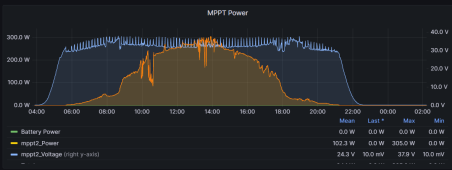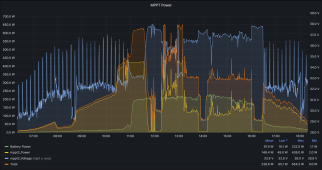I will re-read the thread, but is this the behaviour you are referring to?
Trace 4210N 330W panel. 24V Lithium.
From dawn the panel voltage rises to 28V and basically tracks the battery voltage. Note, I used to think this was "buck converter 100% duty cycle" and a direct connection from panel to battery in low light. However, as you can see, when I upgraded to a 41VoC panel and a 24-28V battery the panel does not directly track the battery voltage, but is offset. So some DC/DC conversion is happening.
Each hour, seemingly around ten to the hour, each hour, it resets the MPPT tracking algorithm, forcing it to go "open circuit" and start hunting from there. Sometimes this initiates the MPPT, sometime it initiates on it's own anyway. MPPT is easy to see working on this fairly dull morning.
It's so dull right now (pouring rain) it gone back into "battery voltage tracking".
Personally, as a professional software engineer, I don't like that hourly reset. It sounds like a hack or a work around for some corner of "double knee" condition which causes the algorithm to get stuck. It's a cheap fix though and when I was designing my own algorithm I had even intended "recon scans" which probably would have ended up looking just like the EPEver approach!
Also note, the spikes are actually amplified as the system beyond the MPPT is under about 150W of load.

Trace 4210N 330W panel. 24V Lithium.
From dawn the panel voltage rises to 28V and basically tracks the battery voltage. Note, I used to think this was "buck converter 100% duty cycle" and a direct connection from panel to battery in low light. However, as you can see, when I upgraded to a 41VoC panel and a 24-28V battery the panel does not directly track the battery voltage, but is offset. So some DC/DC conversion is happening.
Each hour, seemingly around ten to the hour, each hour, it resets the MPPT tracking algorithm, forcing it to go "open circuit" and start hunting from there. Sometimes this initiates the MPPT, sometime it initiates on it's own anyway. MPPT is easy to see working on this fairly dull morning.
It's so dull right now (pouring rain) it gone back into "battery voltage tracking".
Personally, as a professional software engineer, I don't like that hourly reset. It sounds like a hack or a work around for some corner of "double knee" condition which causes the algorithm to get stuck. It's a cheap fix though and when I was designing my own algorithm I had even intended "recon scans" which probably would have ended up looking just like the EPEver approach!
Also note, the spikes are actually amplified as the system beyond the MPPT is under about 150W of load.





